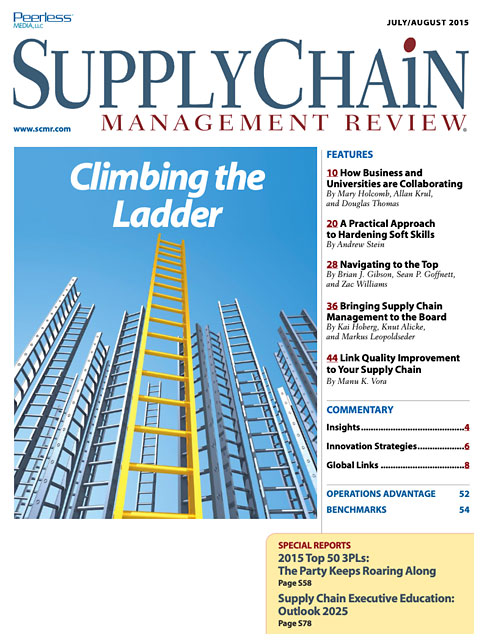Sorry, but your login has failed. Please recheck your login information and resubmit. If your subscription has expired, renew here.
July/August 2015
When it comes to career development, supply chain managers have to execute a bit of jiu jitsu. They’re charged with nding and developing the next generation of talent while simultaneously advancing their own careers in a eld that is often overlooked by senior management. The biggest challenge of all is getting their agenda in front of the Board at a time when supply chain operations are more critical than ever to an organization’s success, but still largely invisible compared to sales, marketing, and product development. Remember: It’s your career—and your supply chain. We hope this month’s issue will help you make the most of both. Browse this issue archive.Need Help? Contact customer service 847-559-7581 More options
It’s difficult for supply chain professionals to comprehend, but most of their colleagues couldn’t care less about fill rates or asset utilization. For that reason, supply chain management in most companies is considered to be everything—except sexy. Supply chain managers who outline their must-win battles regularly point to initiatives like forecast improvement, master data standardization, ERP implementations, or warehouse optimization. These battles are clearly crucial for boosting supply chain performance but, at the same time, they’re a hard sell to senior management. That’s because the concepts and implementations are very technical, understanding interdependencies requires in-depth knowledge, and the actual benefits are difficult to judge.
Moreover, supply chain initiatives are competing for senior management’s attention among many other more accessible—and sexy—topics like market entries, potential acquisitions, or new product launches. When asked for their biggest personal pains, supply chain leaders frequently mention the executive team’s limited interest in supply chain processes or the benefits they provide. Even the hot topics of the day, like Big Data and reshoring, fail to raise the profile of supply chain teams, even though they have been working on these topics for many years.
Of course, there are examples of successful firms that have deeply embedded SCM into their DNA and include SCM topics in Board-level discussions. They understand that SCM—if positioned appropriately and executed correctly—can make the difference between mediocre and outstanding business performance. After all, providing truly distinctive customer service or expanding into new markets is unthinkable without a world-class supply chain to support the chosen strategies. Likewise, inventory reduction is not simply a top-down target set by the financial organization; it takes a supply chain to hit those targets.
 |
This complete article is available to subscribers
only. Click on Log In Now at the top of this article for full access. Or, Start your PLUS+ subscription for instant access. |
SC
MR
Sorry, but your login has failed. Please recheck your login information and resubmit. If your subscription has expired, renew here.
July/August 2015
When it comes to career development, supply chain managers have to execute a bit of jiu jitsu. They’re charged with nding and developing the next generation of talent while simultaneously advancing their own careers… Browse this issue archive. Access your online digital edition. Download a PDF file of the July/August 2015 issue.
 |
Download Article PDF |
It's difficult for supply chain professionals to comprehend, but most of their colleagues couldn't care less about fill rates or asset utilization. For that reason, supply chain management in most companies is considered to be everything—except sexy. Supply chain managers who outline their must-win battles regularly point to initiatives like forecast improvement, master data standardization, ERP implementations, or warehouse optimization. These battles are clearly crucial for boosting supply chain performance but, at the same time, they're a hard sell to senior management. That's because the concepts and implementations are very technical, understanding interdependencies requires in-depth knowledge, and the actual benefits are difficult to judge.
Moreover, supply chain initiatives are competing for senior management's attention among many other more accessible—and sexy—topics like market entries, potential acquisitions, or new product launches. When asked for their biggest personal pains, supply chain leaders frequently mention the executive team's limited interest in supply chain processes or the benefits they provide. Even the hot topics of the day, like Big Data and reshoring, fail to raise the profile of supply chain teams, even though they have been working on these topics for many years.
Of course, there are examples of successful firms that have deeply embedded SCM into their DNA and include SCM topics in Board-level discussions. They understand that SCM—if positioned appropriately and executed correctly—can make the difference between mediocre and outstanding business performance. After all, providing truly distinctive customer service or expanding into new markets is unthinkable without a world-class supply chain to support the chosen strategies. Likewise, inventory reduction is not simply a top-down target set by the financial organization; it takes a supply chain to hit those targets.
 |
SUBSCRIBERS: Click here to download PDF of the full article. |
SC
MR

Latest Supply Chain News
Latest Podcast

 Explore
Explore
Topics
Latest Supply Chain News
- A reshoring history lesson
- Strategic cost savings differ from cutting costs
- Planning fatigue may be settling in
- Inflation, economic worries among top supply chain concerns for SMBs
- April Services PMI declines following 15 months of growth, reports ISM
- Attacking stubborn COGS inflation with Digital Design-and-Source-to-Value
- More latest news
Latest Resources

Subscribe

Supply Chain Management Review delivers the best industry content.

Editors’ Picks





